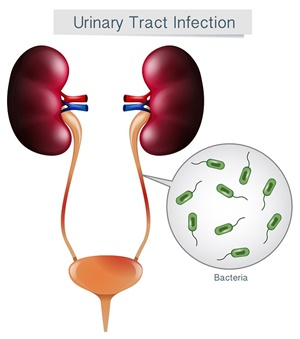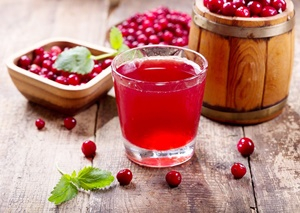 By Dr. Amanda Ng, ND, Canada
By Dr. Amanda Ng, ND, Canada
The urinary tract is part of the excretory system that removes wastes and unnecessary metabolites from the body to maintain homeostasis and biochemical balance. Made up of the kidneys, ureters, bladder, and urethra, the urinary tract is perceived to be sterile, except for the urethra.
A urinary tract infection (UTI) is an infection of any part of the urinary system. Most infections involve the lower urinary tract, which is comprised of the bladder and urethra. Due to the differences in anatomy between men and women, women have a much greater tendency to get UTIs than men. In fact, Canadian women make about 500,000 visits to doctors per year due to UTIs. [1] Due to a shorter urethra in women than in men, bacteria can reach the bladder more easily in women, because they have a shorter distance to travel. [2] The urethra is also located near the anus or rectum in women; therefore, bacteria from the anus and rectum can easily travel up the urethra and cause infections. [2]
Like many health conditions, UTIs may present differently from one individual to another, but there are hallmark signs that point in the direction of a UTI. Typical signs and symptoms of a UTI include: [2]
- A burning sensation when you void;
- Feeling like you need to void more often than usual;
- Feeling the urge to void but not being able to do so;
- Leaking or incontinence;
- Cloudy, dark, malodorous, or bloody urine; and
- Feeling pressure or mild discomfort in the lower abdomen
Symptoms such as nausea, lower back pain, fever, chills, and feeling ill may be signs of a more serious kidney infection, which is warranted for more immediate medical attention.[2]
Common Causes
More than 80% of UTIs in healthy individuals are caused by uropathogenic Escherichia coli (UPEC), with the remainder being caused by other bacterial strains such as Klebsiella pneumoniae, Streptococcus spp., Staphylococcus epidermidis, Pseudomonas aeruginosa, and Enterococcus spp.[3][4] These various strains of bacteria can be found as part of the human microflora, primarily in the gastrointestinal tract. Once inside the urinary tract, bacteria colonize  the bladder and can also ascend through the ureters into the kidneys.[5]
the bladder and can also ascend through the ureters into the kidneys.[5]
Diagnosis
The gold standard for the diagnosis of a UTI is the detection of the pathogen in the presence of clinical symptoms.[6] Diagnosis of an uncomplicated UTI involves a dipstick chemical urinalysis revealing positive leukocyte esterase, which determines the presence of white blood cells in the urine (pyuria).[7:448–449] In addition, urine microscopy or urine culture can be used to specifically identify the offending pathogen as well as estimate the number of bacterial cells involved.[7:448–449]
Conventional and Naturopathic Treatment
Antibiotics: Antibiotics are effective in the treatment of UTIs and for low-dose antibiotic prophylaxis. Antibiotic medications such as MacroBid (nitrofurantoin) and Bactrim (trimethoprim/sulfamethoxazole) are most commonly prescribed for treating UTIs, typically for the course of 7 to 10 days. However, there are side effects associated with the use of antibiotics, such as digestive disturbances as well as contribution to the increase in drug-resistant bacteria with overuse. Drug-resistant bacteria has increasingly become a public health concern; therefore, minimizing the overuse of antibiotics and practising proper antibiotic use is of importance. From a naturopathic perspective, uncomplicated UTIs are relatively simple to treat nutritionally and usually do not require antibiotics. However, when patients report no symptomatic improvements after nutritional treatments, they should be referred to a medical doctor for antibiotic treatment.[6]
Drink More Water: Although urinating can be uncomfortable when you have a UTI, it is important to increase water intake. Drinking plenty of water helps to dilute the urine, which results in more frequent urination, therefore allowing bacteria to be flushed out of the urinary tract. Drinking water to dilute the urine is also a way to deprive bacteria of adequate nutrition, minimizing their capability of colonizing the urinary tract. Studies have demonstrated a 7% higher risk in developing a UTI in people who drank less than one litre of water daily in comparison to those who drank more than one litre daily.[8] Overall, increasing water intake has shown to decrease the risk of UTIs by 45% for the general population and 33% for those who experience recurrent UTIs.[9]
Cranberry (Vaccinium macrocarpon): Cranberries have been the most widely known and used natural treatment for UTIs.  Most commonly used in the form of juice, cranberry is also effective in the form of capsules and tableted extracts. Cranberries contain proanthocyanidins, which inhibit the adhesion of bacteria, most specifically E. coli, to the bladder mucosa, thereby impairing colonization and subsequent infection. [10][11] The acidic nature of cranberries may also play a role in their antibacterial effect, where they are perceived to lower urinary pH. [12] Daily consumption of cranberry juice and tableted extracts has been shown to decrease antibiotic use by 20% in patients who experience at least one UTI per year. Cranberry juice daily has also shown to reduce the levels of white blood cells and bacterial cells in urine samples. [13] Unfortunately, data to support the use of cranberry as a treatment for symptomatic UTIs is limited. However, in clinical practice, cranberry was shown to be effective in the prevention of UTIs and when used in conjunction with other forms of treatment. [13]
Most commonly used in the form of juice, cranberry is also effective in the form of capsules and tableted extracts. Cranberries contain proanthocyanidins, which inhibit the adhesion of bacteria, most specifically E. coli, to the bladder mucosa, thereby impairing colonization and subsequent infection. [10][11] The acidic nature of cranberries may also play a role in their antibacterial effect, where they are perceived to lower urinary pH. [12] Daily consumption of cranberry juice and tableted extracts has been shown to decrease antibiotic use by 20% in patients who experience at least one UTI per year. Cranberry juice daily has also shown to reduce the levels of white blood cells and bacterial cells in urine samples. [13] Unfortunately, data to support the use of cranberry as a treatment for symptomatic UTIs is limited. However, in clinical practice, cranberry was shown to be effective in the prevention of UTIs and when used in conjunction with other forms of treatment. [13]
Vitamin C: Vitamin C is most effective in the prevention of recurrent UTIs, where daily supplementation can lower occurrences by 12.5%. [13] Similar to cranberry, vitamin C has been shown to be most effective against E. coli. Vitamin C exhibits bacteriostatic effects by increasing the production of nitric oxide in acidified urine, thereby decreasing the growth and reproduction of bacteria. [14]
D-Mannose: D-Mannose is a naturally occurring sugar closely related to glucose but does not have the same effect on the body. Unlike glucose, D mannose does not affect blood sugar levels as it is not metabolized in the body in the same way. D Mannose is primarily filtered through the kidneys and excreted in the urine. Due to this unique quality, D mannose is effective in the prevention of UTIs, where it inhibits the adherence of bacteria to the bladder mucosa. [15] Upon contact with bacteria, D mannose coats the offending bacteria, prevents adhesion to the bladder, and allows them to be flushed away during urination. In comparison to antibiotics, D mannose reduces the risk of recurrent UTIs just as effectively as nitrofurantoin, with the added benefit of having a significantly lower risk of side effects. [16]
Berberine: Found in many plants including goldenseal (Hydrastis canadensis), Oregon-grape (Mahonia aquifolium), and barberry (Berberis vulgaris), berberine is an alkaloid which has significant antimicrobial activity against a variety of microorganisms. Berberine acts as a physical barrier by preventing bacteria from adhering to the bladder mucosa. [13] Berberine also directly affects the growth and reproduction of bacteria, by damaging the structure of the bacterial cell membrane and by inhibiting the synthesis of protein and DNA. [17] Due to the fact that most UTIs are caused by migration of bacteria from the gastrointestinal tract, the treatment of gastrointestinal infections or bacterial overgrowth with berberine can indirectly impact the occurrences of UTIs. [13]
Bearberry (Arctostaphylos uva-ursi): Bearberry is one of the most commonly used antimicrobial botanicals for UTIs. Bearberry contains arbutin, which has antimicrobial effects by changing the structure of bacterial cell walls, thereby preventing adhesion to the bladder mucosa. Arbutin is unique where a urine pH of at least 8 is needed for optimal results. [13] Increasing urine alkalinity can be achieved by increasing vegetables in the diet or by sodium-bicarbonate supplementation. [13] Bearberry also demonstrates diuretic and anti-inflammatory effects which are beneficial properties for the treatment of UTIs.
Conclusion: With the numerous natural treatment options available, UTIs are relatively uncomplicated and simple to treat at the first sign of infection. Using various treatments that work via different mechanisms often yields the best outcomes. Certain nutritional and botanical compounds are not intended for long-term use or during pregnancy and lactation. Therefore, it is important to work with a naturopathic doctor when it comes to determining the correct course of treatment.
REFERENCES : 1. The Kidney Foundation of Canada. Urinary tract infections. 2007. · https://www.kidney.ca/document.doc?id=316 2. The College of Family Physicians of Canada. Urinary tract infections - A common problem for some women. 2010. · http://www.cfpc.ca/ProjectAssets/Templates/Resource.aspx?id=3809 3. Abraham, S.N., and Y. Miao. “The nature of immune responses to urinary tract infections.” Nature Reviews. Immunology. Vol. 15, No. 10 (2015): 655–663. 4. Behzadi, P., et al. “A survey on urinary tract infections associated with the three most common uropathogenic bacteria.” Mædica, Vol. 5, No. 2 (2010): 111–115. 5. Wiles, T.J., R.R. Kulesus, and M.A. Mulvey. “Origins and virulence mechanisms of uropathogenic Escherichia coli.” Experimental and Molecular Pathology, Vol. 85, No. 1 (2008): 11–19. 6. Schmiemann, G., et al. “The diagnosis of urinary tract infection—A systematic review.” Deutsches Ärzteblatt International, Vol. 107, No. 21 (2010): 361–367. 7. Prousky, J. Textbook of integrative clinical nutrition. Toronto, CCNM Press Inc, 2013, 506 p., ISBN 978 1 8970 2545 1. 8. Zincir, H., et al. “Prevalence of urinary tract infections and its risk factors in elementary school students.” Urologia Internationalis, Vol. 88, No. 2 (2012): 194–197. 9. Bruyere, F., et al. “Urinary tract infections: Economical impact of water intake.” Progrès En Urologie, Vol. 25, No. 10 (2015): 590–597.
 The D-Manocist from New Roots Herbal is a specific formula consisting of D-Mannose, a natural sugar which has no effect on glucose metabolism, 600 mg of ultra-concentrated cranberry extract (107:1) equivalent to 64,2 g per use, and Lactobacillus rhamnosus.
The D-Manocist from New Roots Herbal is a specific formula consisting of D-Mannose, a natural sugar which has no effect on glucose metabolism, 600 mg of ultra-concentrated cranberry extract (107:1) equivalent to 64,2 g per use, and Lactobacillus rhamnosus.
UK and Ireland practitioners can purchase this product from the Natural Dispensary For availability in other countries check here.




You must be logged in to post a comment.
click here to log in